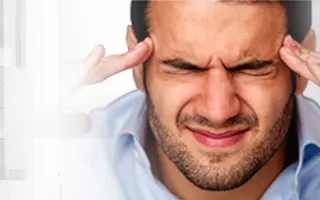Migraine - Symptoms
In most cases, migraines progress through four stages:
- Pro-drome- One or two days before a migraine attack, a patient experiences mild changes that warn them of an upcoming migraine. The changes include the following:
- constipation;
- mood changes, from depression to euphoria (a feeling of intense excitement);
- food cravings;
- neck stiffness;
- increased thirst and urination; and
- frequent yawning.
Aura - An aura may occur before or during migraines, though many people experience migraine pains without the aura. Auras are symptoms of the nervous system. They are usually disturbances related to the vision, such as flashes of light or wavy, zigzag vision. Sometimes auras can also be related to disturbances in the sense of touch, movement or speech. The patient’s muscles may get weak or they may feel as though someone is touching them. Each of these symptoms begins gradually, builds up over several minutes and lasts for 20 to 60 minutes. Examples of migraine auras are as follows:
- disturbances of vision such as seeing various shapes, bright spots or flashes of light;
- vision loss;
- pins and needles sensations in either of the arms or legs;
- weakness or numbness in the face or on one side of the body;
- difficulty in speech;
- hearing noises or music;
- uncontrollable jerking or other bodily movements; and
- sometimes associated limb weakness.
- Main headache attack- A migraine usually lasts for 4 to 72 hours if untreated. The frequency with which headaches occur vary from person to person. During a migraine, one may experience the following:
- pain on either or both sides of the head;
- throbbing and pulsing pain;
- sensitivity to light, sounds and sometimes even smells and touch;
- nausea and vomiting;
- blurred vision; and
- lightheadedness, sometimes followed by fainting.
- Post-drome- The final phase, known as post-drome, occurs after a migraine attack. Some patients feel drained and washed out, while some feel elated. For the next 24 hours, the patient may also experience the following:
- confusion;
- moodiness;
- dizziness;
- weakness; and
- sensitivity to light and sound.
Complications
Status migrainosus: This rare and severe migraine with aura lasts for longer than 72 hours.
Migrainous infarction: This is when a migraine is associated with brain stroke. Typically, this is a migraine headache with an aura that lasts more than an hour. An aura that lasts longer than an hour can be a sign of bleeding in the brain.
Persistent aura without infarction: This complication arises if an aura lasts for more than a week after a migraine has ended. This complication has similar symptoms to migrainous infarction, but there is no bleeding in the brain.
Migralepsy: This is a condition where an attack of fits is triggered by a migraine.
Stroke: A brain stroke occurs when blood supply to the brain is cut off or blocked by a blood clot or fatty material in the arteries.
Mental health issues: According to the Anxiety and Depression Association of America, migraines have been associated with a small increased risk of depression and anxiety.
Other complications: Migraines can also bring on symptoms like motion sickness, sleepwalking, sleep talking, night terrors and teeth grinding. Additionally, migraines can bring on abdominal pain, cyclical vomiting and vertigo.
Complications due to medications: It is frequently observed that because migraines recur, people frequently overuse pain medications. Frequent and unguided use of pain medicines lead to abdominal complaints such as gas and acidity to more severe conditions like bleeding.
Medication overuse headache (rebound headache): Continual, long-term use of medications used to treat migraines can cause a rebound headache also known as a medication overuse headache. This can lead to a cycle where taking too much medication causes a rebound headache, which then necessitates taking more medication, which causes worse headaches and so on.




